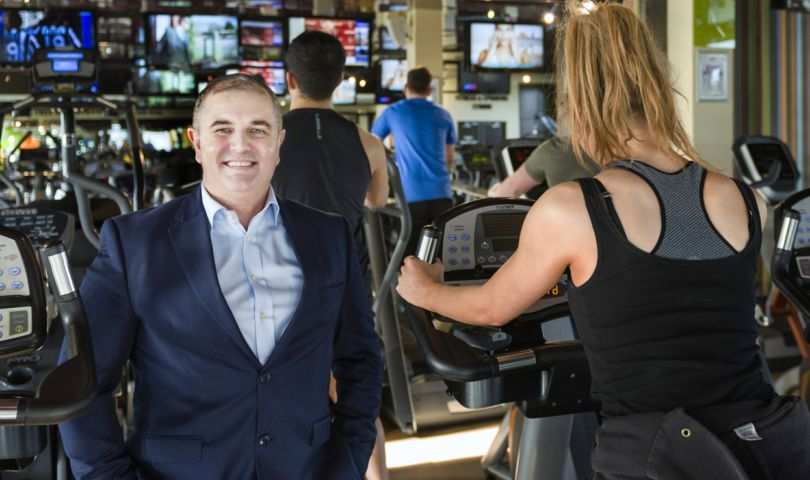The West Wood chain of fitness clubs sees a big future in Les Mills choreographed fitness classes, writes Emily Styles
Been to the gym lately? If you haven’t, you could be surprised by what you find, at least at one of the West Wood fitness clubs in Dublin. The weight rooms and treadmills are still there but the new fitness trend is immersive. What that means is a huge room with projected images and loud music redolent of an Ibiza disco. Aerobics have become more collective and more fun, and you work up a sweat on a Spinning bike while an Electronic Arts-type vista surrounds your vision.
These choreographed exercise-to-music group fitness classes are off the shelf, supplied by New Zealand company Les Mills. For example, ‘The Trip’ is a 40- minute class that takes place in front of a huge IMAX screen. It uses digital projection, light and sounds to transport the gym bunnies into numerous different worlds including underground caves and outer space.
Alan Leach (pictured), general manager of the West Wood Club chain, is a big believer in the Les Mills approach. In Leach’s view, making fitness fun, engaging and communal is the key factor underpinning the success of the business. And now he’s spreading the mantra to three more Dublin gyms.
West Wood used to consist of gyms in Leopardstown, Clontarf and Sandymount. In July 2016, the business bought three gyms owned by Crunch Fitness, located in Aston Quay, Dun Laoghaire and Westmanstown. Like West Wood, Crunch operated at the premium end of the market, though they didn’t have the money to go down the Les Mills route. Now they do, with the transformation of the Dun Laoghaire facility completed recently and the other two Crunch clubs currently undergoing an upgrade too.
Premium gyms come with premium pricing. At West Wood, adult membership is €75 a month for access to the six clubs, and the off-peak adult membership rate is €55 a month. By contrast, Flyefit, which operates six gyms around the capital, charges €29 a month or €32 a month to access any of its gyms
Leach, 53, started out his gym career as a teenager, doing weight training and body building long before it was fashionable for young men to nurture their pecs. A gym job followed, and after doing a marketing degree he moved into the management side of the business. He recalls that friends thought he was mad wasting his qualification in the fitness industry, though he notes that now most of West Wood’s staff have third level qualifications.
Fitness is a big and growing business. Leach estimates that 11% of the population are members of a gym or fitness club while the comparable stat in the UK is 14% and 18% in the US. So he sees scope for growth in West Wood’s expanded chain, as he explained in conversation with Business Plus recently.
What attracted West Wood to Crunch Fitness?
Crunch Fitness had three health clubs at the premium end of the market like us, so it was a very close fit. The clubs are in Dublin, which was another deciding factor. We have been able to add our management structures and marketing system, in addition to undertaking substantial investment in the facilities.
The acquisition has increased West Wood group membership by 11,000 to 33,000, which we estimate is around 30% market share in Dublin. The group employment is now over 420 people. The Crunch members are all aware of our investment programme and the new concepts, so I’m confident about the transition.
We recently completed the upgrade of the former Crunch Fitness club in Dun Laoghaire, which has cost in excess of €2.5m. The same type of upgrade is occurring in Aston Quay and Westmanstown. When we’re finished, all the clubs will have the Les Mills immersive fitness facilities, improved exercise machines and soft water pools.
What’s so special about the Les Mills concept?
They were the first to brand a group fitness class in a way that is pre-choreographed. So if you do a Les Mills workout in in Dublin or New York or London, you’ll find that the same type of same class. It requires a huge amount of investment in sound systems and screens. Each Les Mills studio in our clubs costs from €160,000 to €250,000, depending on the number of projectors.
Les Mills classes are updated every three months and set to new music, which keeps them relevant and popular. The premise behind it is that when you are distracted by the stunning visuals you don't realise just how hard you are working out.
How popular are these immersive workouts with our members?
In the three original West Wood clubs, there are 39,000 visits a month to the Les Mills classes. Our clubs cater for different segments. There are people who lift weights in the gym or just come for a swim or to play a game of tennis. And then you have this very large segment that loves group fitness, or what used to be called aerobics. The reason is that it’s a lot more enjoyable to participate in cardiovascular exercise with other people and amazing instructors than to stand on a treadmill looking at the wall.
Men make up 35/40% of these classes, depending on the type of class. People are educated now about the necessity of doing cardio exercise. You can go on the treadmill, go on the bike, walk around the park or you can run up and down the stairs. The idea with the group fitness class is that you are doing the cardio with other people, so the 35 or 45 minutes goes by very quickly, especially with the Les Mills immersive screens. A lot of these new fitness concepts is about making fitness more enjoyable.
In our business, everyone pays for their membership on monthly basis now, and if they don’t use the club they’ll be gone sooner or later. The person who goes to a Les Mills class twice a week does not leave, because they get to know the people in the classes and they enjoy the social element. The risk is always the person who’s just on the treadmill.
What’s important from a marketing perspective for growing a membership business?
I firmly believe that you shouldn’t spend a fortune trying to change someone’s mind. You’re better off to conduct market research and find out what you are known for, good and bad, and then work with that. Our market research years ago told us that West Wood was perceived as more than just a gym, and that we had a reputation for group fitness. So we made the decision to try to be the best in our sector at group fitness. That strategy has driven our investment programmes and the attendant marketing.











